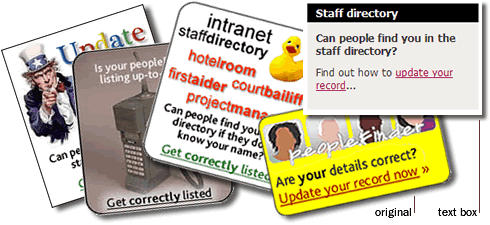The WonderWall module of GovIntranet has been in place on a number of client intranets for a few years. And now we have seen the first self-nomination on a wall.
Cracks in the wall

Social aspects on the intranet including voting, rating, sharing, bookmarking, blogging, forums, wikis.

The WonderWall module of GovIntranet has been in place on a number of client intranets for a few years. And now we have seen the first self-nomination on a wall.

Since releasing the new intranet for the Royal Botanic Gardens, the team has been working to iterate functionality and implement features based on staff feedback and new requirements.

It started, as many new GovIntranet features do, with an idea from the Department for Digital, Culture, Media and Sport. The internal communications team wanted a way for staff to post recognition and praise for other members of staff on the intranet.

It’s interesting to hear that the digital team at the Ministry of Justice have developed a new staff directory. I know a few departments are already opting to use this service and it will be interesting to follow progress.

The Enterprise Strategies post uses statistics from the Worldwide Intranet Challenge to analyse the aspects of an intranet that most impact a user’s perception of the intranet. The main 2 conclusions state:
With 99+% confidence, we can conclude that:
THE MORE OFTEN EMPLOYEES USE THEIR INTRANET TO DO THESE THREE THINGS, THE HIGHER THEIR OVERALL VALUATION OF THEIR INTRANET:
- Complete online forms
- Upload or download documents
- Find instructions for completing work tasks
And
With 94% confidence, we can conclude that:
THE MORE OFTEN EMPLOYEES USE THEIR INTRANET TO PROVIDE FEEDBACK OR COMMENTS ABOUT INTRANET CONTENT, THE HIGHER THEIR OVERALL VALUATION OF THEIR INTRANET.
To me, this says that a task-based intranet that allows staff to find instructions and complete tasks online, is very valuable. And if staff can provide feedback or comment on the intranet content then this adds to the value.
It doesn’t prove a case for a “social intranet”. It doesn’t show that staff want to post and like and comment on others’ posts. In fact, the post goes on to note that other features such as being able to discuss work topics online in a forum or collaborating in shared spaces didn’t score as high, and then claims that these features were not available in 2009 and makes the assumption that the WIC results would have shown higher scores if staff could have accessed these features. This assumption is then taken as additional evidence to support proof of a requirement for a social intranet.
I’d argue that forums and shared spaces were not strangers to the intranet scene in 2009. The report doesn’t state the actual years that have been analysed but the WIC is still current and so I find this could’ve/would’ve, distorted interpretation to be somewhat misleading and biased.
Despite the wonkiness of the post title and the biased analysis, the report hammers home the facts that using the intranet for finding instructions, completing tasks and being able to feedback on intranet content are the most important aspects of a user’s perception of the intranet.